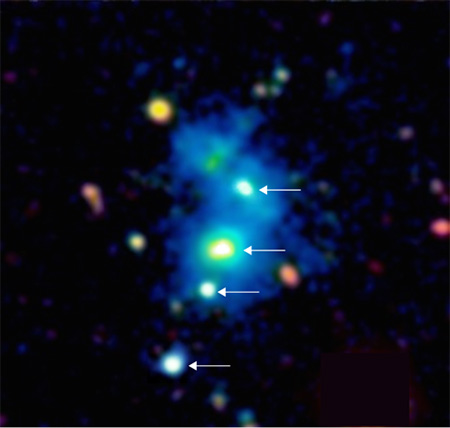A team of astronomers including J. Xavier Prochaska, professor of astronomy and astrophysics at UC Santa Cruz, has discovered the first known quasar quartet: four quasars, each one a rare object in its own right, in close physical proximity to each other. The quartet resides in one of the most massive structures ever discovered in the distant universe (a "proto-cluster" of galaxies) and is surrounded by a giant nebula of cool dense gas.
The findings, published May 15 in Science, are based on observations using the 10-meter Keck I Telescope at the W. M. Keck Observatory in Hawaii. Either the discovery is a one-in-ten-million coincidence, or cosmologists need to rethink their models of quasar evolution and the formation of the most massive cosmic structures, according to first author Joseph Hennawi of the Max Planck Institute for Astronomy (MPIA) in Heidelberg, Germany.
Exceedingly rare
Quasars constitute a brief phase of galaxy evolution, powered by the accretion of matter onto a supermassive black hole at the center of a galaxy. During this phase, they are the most luminous objects in the universe, shining hundreds of times brighter than their host galaxies, which themselves contain hundreds of billions of stars. But these hyper-luminous episodes last only a tiny fraction of a galaxy's lifetime. As a result, quasars are exceedingly rare and are typically separated by hundreds of millions of light years from one another. The researchers estimate that the odds of discovering a quadruple quasar by chance is one in ten million.
How did they get so lucky? Clues come from peculiar properties of the quartet's environment. The four quasars are surrounded by a giant nebula of cool dense hydrogen gas, which emits light because it is irradiated by the intense glare of the quasars. In addition, both the quartet and the surrounding nebula reside in an unusual region of the universe with a surprisingly large amount of matter.
"There are several hundred times more galaxies in this region than you would expect to see at these distances," said Prochaska, the principal investigator of the Keck observations.
Proto-cluster
Given the exceptionally large number of galaxies, this system resembles the massive agglomerations of galaxies known as galaxy clusters that astronomers observe in the present-day universe. But because the light from this cosmic metropolis has been travelling for 10 billion years before reaching Earth, the images show the region as it was 10 billion years ago, less than 4 billion years after the big bang. It is thus an example of a proto-cluster, the progenitor or ancestor of a present-day galaxy cluster.
Piecing all of these anomalies together, the researchers tried to understand what appears to be their incredible stroke of luck. "If you discover something which, according to current scientific wisdom, should be extremely improbable, you can come to one of two conclusions: either you just got very lucky, or you need to modify your theory," Hennawi said.
The researchers speculate that some physical process might make quasar activity much more likely in certain environments. One possibility is that quasar episodes are triggered when galaxies collide or merge, because these violent interactions efficiently funnel gas onto the central black hole. Such encounters are much more likely to occur in a dense proto-cluster filled with galaxies, just as one is more likely to encounter traffic when driving through a big city.
"The giant emission nebula is an important piece of the puzzle, since it signifies a tremendous amount of dense cool gas," said coauthor Fabrizio Arrigoni-Battaia of MPIA. Supermassive black holes can only shine as quasars if there is gas for them to swallow, and an environment that is gas rich could provide favorable conditions for fueling quasars.
Unexpected
On the other hand, given the current understanding of how massive structures in the universe form, the presence of the giant nebula in the proto-cluster is totally unexpected, according to coauthor Sebastiano Cantalupo of UC Santa Cruz and ETH Zurich. "Our current models of cosmic structure formation based on supercomputer simulations predict that massive objects in the early universe should be filled with rarefied gas that is about ten million degrees, whereas this giant nebula requires gas thousands of times denser and colder," he said.
The discovery of the first quadruple quasar may force cosmologists to rethink their models of quasar evolution and the formation of the most massive structures in the universe.



